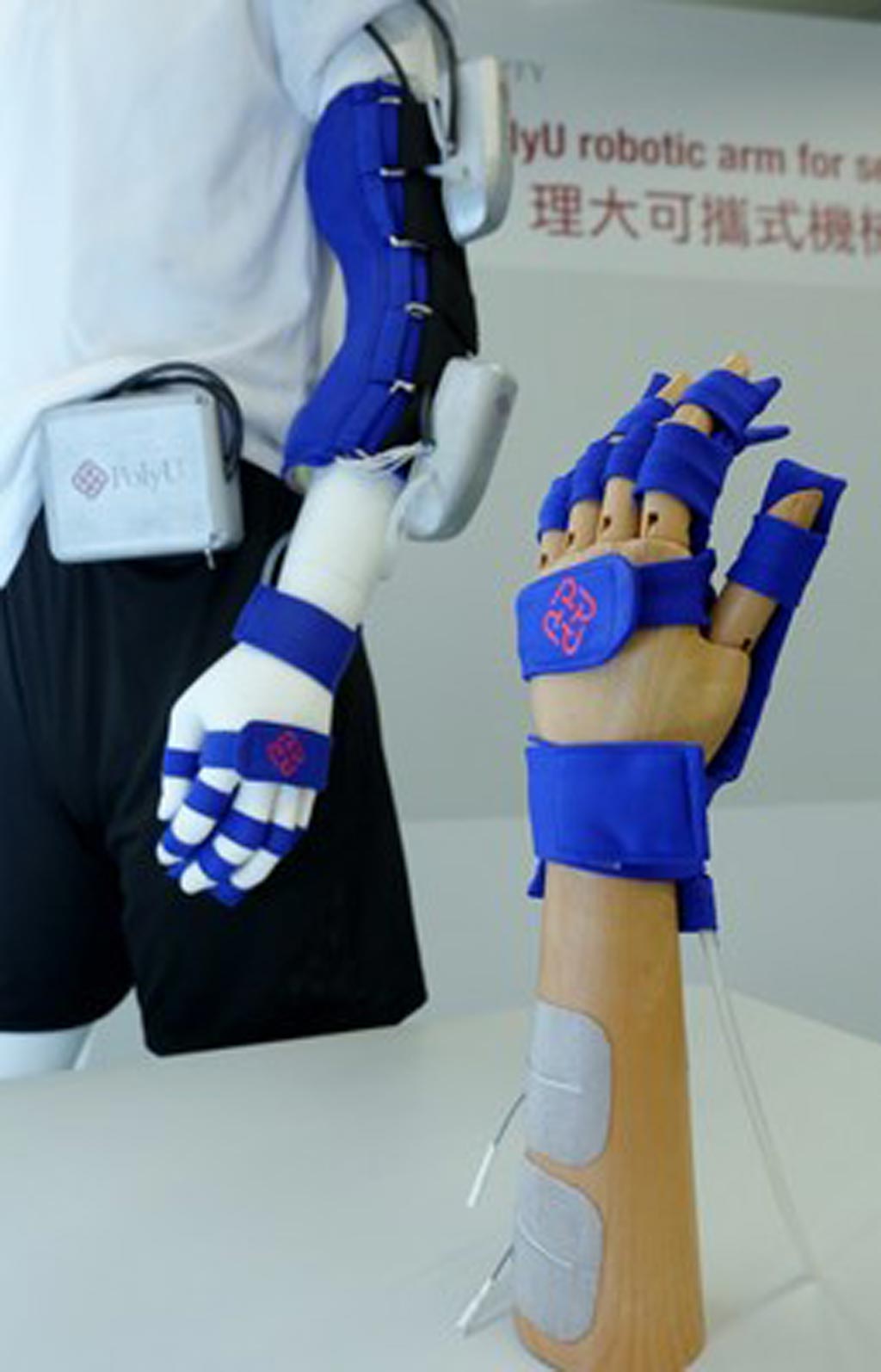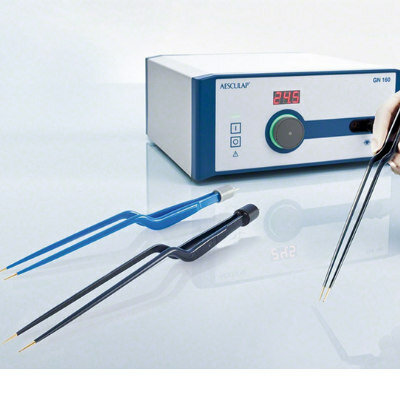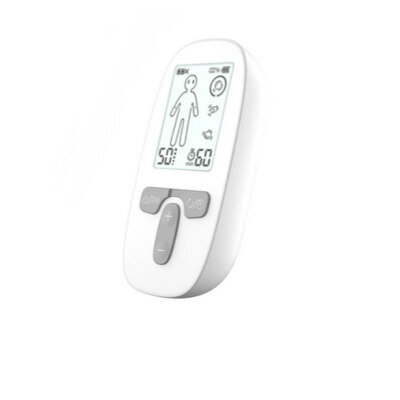Robotic Arm Helps Rehabilitate Stroke Patients
|
By HospiMedica International staff writers Posted on 15 Nov 2018 |

Image: A rehabilitation device combines an exo-skeleton and soft robotics (Photo courtesy of PolyU).
A new robotic arm enables stroke patients to independently engage in intensive and effective self-help rehabilitation exercise once discharged from hospital.
The mobile exo-neuro-musculo-skeleton represents an innovative integration of exo-skeleton materials, soft robotics, and neuro-muscular electrical stimulation (NMES) technologies. The working principle of both exo-skeleton and soft robotic designs is to provide external mechanical forces that are driven by voluntary muscle signals that assist the patient's desired joint movement. The robotic arm, developed at Hong Kong Polytechnic University (PolyU) thus includes components for wrist/hand, elbow, and fingers, which can be worn separately or together for different functional training needs.
The robotic arm, which is light in weight, compact in size, fast in response, and with minimal power demands, is suitable for both indoor and outdoor environments. Once electromyography signals sent to the muscles are detected, the arm responds by applying NMES to help contract them, as well as exerting external mechanical forces to assist the desired voluntary movement. The combination of increased muscle strength triggered by NMES and external mechanical forces is 40% more effective for stroke rehabilitation than applying external mechanical forces alone.
Features include a lightweight design (up to 300g for wearable upper limb components, which are fit for different functional training needs), a low power demand (12V rechargeable battery supply for 4-hour continuous use), and a sportswear design that uses washable fabric with ultraviolet (UV) protection and good ventilation, . A value-added feature is a mobile app that allows users to control their own training. The app also records real-time training data for better monitoring of the rehabilitation progress by both healthcare practitioners and the patients themselves.
“We are confident that with our mobile exo-neuro-musculo-skeleton, stroke patients can conduct rehabilitation training anytime and anywhere, turning the training into part of their daily activities,” said Hu Xiao-ling, PhD, and colleagues of the PolyU department of biomedical engineering (BME). “We hope such flexible self-help training can well supplement traditional outpatient rehabilitation services, helping stroke patients achieve a much better rehabilitation progress.”
Intensive, repeated, and long-term rehabilitation training are critical for enhancing the physical mobility of stroke patients, helping to alleviate post-stroke symptoms such as disability. But the vast demand for outpatient rehabilitation services for stroke patients results in long queues forming for every available slot, and patients do not receive timely and routine rehabilitation exercises. Stroke patients also find it challenging to travel from home to outpatient clinics.
Related Links:
Hong Kong Polytechnic University
The mobile exo-neuro-musculo-skeleton represents an innovative integration of exo-skeleton materials, soft robotics, and neuro-muscular electrical stimulation (NMES) technologies. The working principle of both exo-skeleton and soft robotic designs is to provide external mechanical forces that are driven by voluntary muscle signals that assist the patient's desired joint movement. The robotic arm, developed at Hong Kong Polytechnic University (PolyU) thus includes components for wrist/hand, elbow, and fingers, which can be worn separately or together for different functional training needs.
The robotic arm, which is light in weight, compact in size, fast in response, and with minimal power demands, is suitable for both indoor and outdoor environments. Once electromyography signals sent to the muscles are detected, the arm responds by applying NMES to help contract them, as well as exerting external mechanical forces to assist the desired voluntary movement. The combination of increased muscle strength triggered by NMES and external mechanical forces is 40% more effective for stroke rehabilitation than applying external mechanical forces alone.
Features include a lightweight design (up to 300g for wearable upper limb components, which are fit for different functional training needs), a low power demand (12V rechargeable battery supply for 4-hour continuous use), and a sportswear design that uses washable fabric with ultraviolet (UV) protection and good ventilation, . A value-added feature is a mobile app that allows users to control their own training. The app also records real-time training data for better monitoring of the rehabilitation progress by both healthcare practitioners and the patients themselves.
“We are confident that with our mobile exo-neuro-musculo-skeleton, stroke patients can conduct rehabilitation training anytime and anywhere, turning the training into part of their daily activities,” said Hu Xiao-ling, PhD, and colleagues of the PolyU department of biomedical engineering (BME). “We hope such flexible self-help training can well supplement traditional outpatient rehabilitation services, helping stroke patients achieve a much better rehabilitation progress.”
Intensive, repeated, and long-term rehabilitation training are critical for enhancing the physical mobility of stroke patients, helping to alleviate post-stroke symptoms such as disability. But the vast demand for outpatient rehabilitation services for stroke patients results in long queues forming for every available slot, and patients do not receive timely and routine rehabilitation exercises. Stroke patients also find it challenging to travel from home to outpatient clinics.
Related Links:
Hong Kong Polytechnic University
Latest Patient Care News
- Revolutionary Automatic IV-Line Flushing Device to Enhance Infusion Care
- VR Training Tool Combats Contamination of Portable Medical Equipment
- Portable Biosensor Platform to Reduce Hospital-Acquired Infections
- First-Of-Its-Kind Portable Germicidal Light Technology Disinfects High-Touch Clinical Surfaces in Seconds
- Surgical Capacity Optimization Solution Helps Hospitals Boost OR Utilization

- Game-Changing Innovation in Surgical Instrument Sterilization Significantly Improves OR Throughput
- Next Gen ICU Bed to Help Address Complex Critical Care Needs
- Groundbreaking AI-Powered UV-C Disinfection Technology Redefines Infection Control Landscape
- Clean Hospitals Can Reduce Antibiotic Resistance, Save Lives
- Smart Hospital Beds Improve Accuracy of Medical Diagnosis
- New Fast Endoscope Drying System Improves Productivity and Traceability
- World’s First Automated Endoscope Cleaner Fights Antimicrobial Resistance
- Portable High-Capacity Digital Stretcher Scales Provide Precision Weighing for Patients in ER
- Portable Clinical Scale with Remote Indicator Allows for Flexible Patient Weighing Use
- Innovative and Highly Customizable Medical Carts Offer Unlimited Configuration Possibilities
- Biomolecular Wound Healing Film Adheres to Sensitive Tissue and Releases Active Ingredients
Channels
Critical Care
view channel
Light-Based Technology to Measure Brain Blood Flow Could Diagnose Stroke and TBI
Monitoring blood flow in the brain is crucial for diagnosing and treating neurological conditions such as stroke, traumatic brain injury (TBI), and vascular dementia. However, current imaging methods like... Read more
AI Heart Attack Risk Assessment Tool Outperforms Existing Methods
For decades, doctors have relied on standardized scoring systems to assess patients with the most common type of heart attack—non-ST-elevation acute coronary syndrome (NSTE-ACS). The GRACE score, used... Read moreSurgical Techniques
view channel
Minimally Invasive Endoscopic Surgery Improves Severe Stroke Outcomes
Intracerebral hemorrhage, a type of stroke caused by bleeding deep within the brain, remains one of the most challenging neurological emergencies to treat. Accounting for about 15% of all strokes, it carries... Read more
Novel Glue Prevents Complications After Breast Cancer Surgery
Seroma and prolonged lymphorrhea are among the most common complications following axillary lymphadenectomy in breast cancer patients. These postoperative issues can delay recovery and postpone the start... Read moreHealth IT
view channel
Printable Molecule-Selective Nanoparticles Enable Mass Production of Wearable Biosensors
The future of medicine is likely to focus on the personalization of healthcare—understanding exactly what an individual requires and delivering the appropriate combination of nutrients, metabolites, and... Read moreBusiness
view channel
Philips and Masimo Partner to Advance Patient Monitoring Measurement Technologies
Royal Philips (Amsterdam, Netherlands) and Masimo (Irvine, California, USA) have renewed their multi-year strategic collaboration, combining Philips’ expertise in patient monitoring with Masimo’s noninvasive... Read more
B. Braun Acquires Digital Microsurgery Company True Digital Surgery
The high-end microsurgery market in neurosurgery, spine, and ENT is undergoing a significant transformation. Traditional analog microscopes are giving way to digital exoscopes, which provide improved visualization,... Read more
CMEF 2025 to Promote Holistic and High-Quality Development of Medical and Health Industry
The 92nd China International Medical Equipment Fair (CMEF 2025) Autumn Exhibition is scheduled to be held from September 26 to 29 at the China Import and Export Fair Complex (Canton Fair Complex) in Guangzhou.... Read more
















